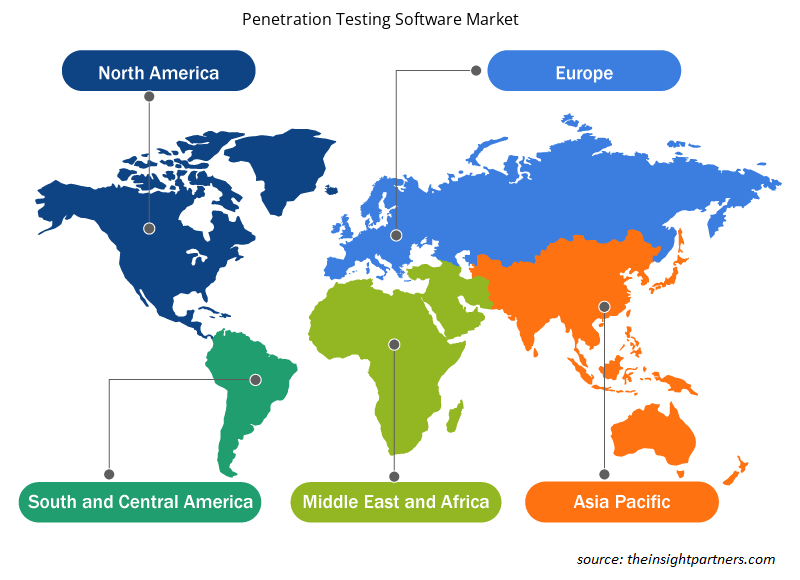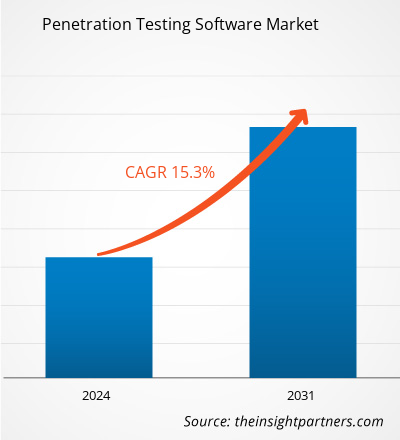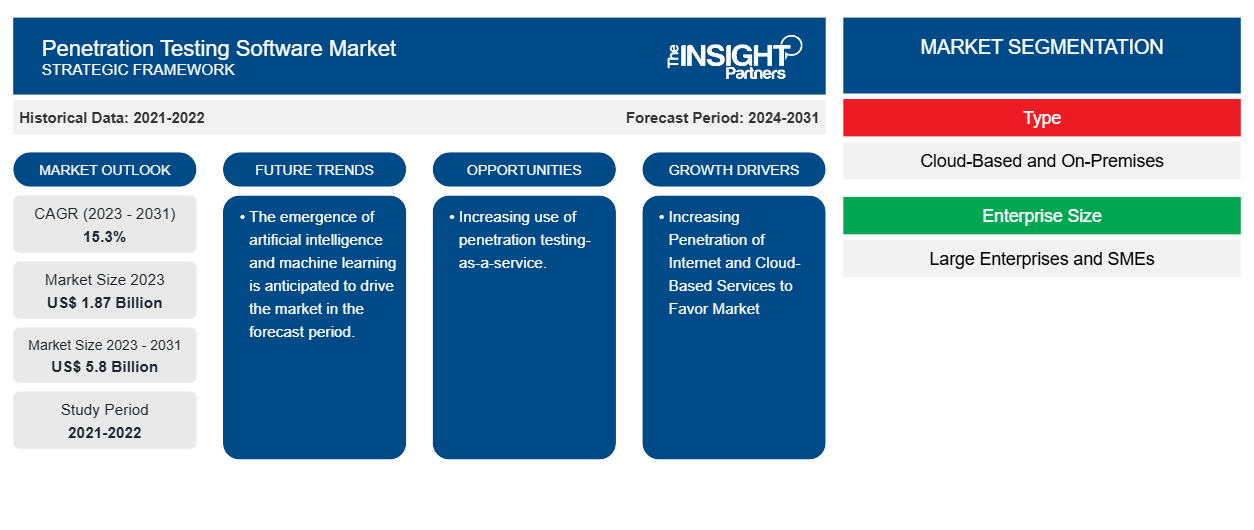Der Markt für Penetrationstestsoftware soll von 1,87 Milliarden US-Dollar im Jahr 2023 auf 5,85 Milliarden US-Dollar im Jahr 2031 anwachsen. Der Markt soll zwischen 2023 und 2031 eine durchschnittliche jährliche Wachstumsrate (CAGR) von 15,3 % verzeichnen. Die zunehmende Verbreitung internet- und cloudbasierter Dienste sowie immer strengere Regeln und Compliance-Anforderungen, die den Einsatz von Penetrationstestsoftware erforderlich machen, dürften die wichtigsten Trends und Treiber für den Markt für Penetrationstestsoftware sein.CAGR of 15.3% during 2023–2031. The rise in penetration of internet and cloud-based services and increasingly stringent rules and compliance requirements to necessitate the use of penetration testing software are likely to be the key trends and drivers for the penetration testing software market.
Marktanalyse für Penetrationstest-Software
Der Markt für Penetrationstestsoftware verzeichnet weltweit ein deutliches Wachstum. Dieses Wachstum ist auf die zunehmende Verbreitung internet- und cloudbasierter Dienste sowie auf immer strengere Regeln und Compliance-Anforderungen zurückzuführen, die den Einsatz von Penetrationstestsoftware erforderlich machen. Darüber hinaus wird erwartet, dass der zunehmende Trend zu Penetrationstests als Service und Sicherheit bei der Fernarbeit sowie die Entstehung von Bereitstellungsmodellen auf Basis künstlicher Intelligenz und maschinellem Lernen in den kommenden Jahren zahlreiche Chancen für den Markt bieten werden.
Marktübersicht für Penetrationstest-Software
Penetrationstests (oder Penetrationstests) sind Sicherheitsübungen, bei denen ein Cybersicherheitsexperte versucht, Schwachstellen in einem Computersystem zu finden und auszunutzen . Der Zweck dieses simulierten Angriffs besteht darin, Schwachstellen in der Abwehr eines Systems zu identifizieren, die Angreifer ausnutzen könnten.cyber-security expert attempts to find and exploit vulnerabilities in a
Passen Sie diesen Bericht Ihren Anforderungen an
Sie erhalten kostenlos individuelle Anpassungen an jedem Bericht, einschließlich Teilen dieses Berichts oder einer Analyse auf Länderebene, eines Excel-Datenpakets sowie tolle Angebote und Rabatte für Start-ups und Universitäten.
- Holen Sie sich die wichtigsten Markttrends aus diesem Bericht.Dieses KOSTENLOSE Beispiel umfasst eine Datenanalyse von Markttrends bis hin zu Schätzungen und Prognosen.
Treiber und Chancen auf dem Markt für Penetrationstest-Software
Zunehmende Durchdringung des Internets und Cloud-basierter Dienste begünstigt den Markt.
Das Internet bietet eine schier endlose Liste von Diensten: Es ermöglicht weltweite Kommunikation und Zusammenarbeit, sendet international Geld (einschließlich Überweisungen), lernt und bildet andere, bildet grenzüberschreitende soziale Verbindungen, teilt Nachrichten und vieles mehr. 63 % der Weltbevölkerung waren im Jahr 2023 online, da die Internetdurchdringung die Möglichkeit von Schwachstellen und Phishing-Angriffen erhöht. Das Ziel von Netzwerk-Penetrationstests besteht darin, Schwachstellen innerhalb der Organisation aufzudecken und zu identifizieren. Dazu gehört eine eingehende Bewertung der Netzwerksicherheitsmaßnahmen durch externe und interne Tests, wie z. B. Tests von Webanwendungen und simulierte Phishing-Angriffe. Unter Berücksichtigung der oben genannten Parameter treiben also die zunehmenden Parameter internet- und cloudbasierter Dienste den Markt an.
Zunehmende Nutzung von Penetrationstests als Dienstleistung.
PTaaS ist eine Methode für Penetrationstests, die manuelle und menschliche Tests auf einer Cloud-Bereitstellungsplattform zusammenführt, um es IT-Experten zu ermöglichen, zeitpunktbezogene und kontinuierliche Penetrationstests durchzuführen. Die Nutzung von PaaS nimmt zu, da Unternehmen damit Schwachstellen identifizieren und beheben können, ohne dass umfangreicher Personaleinsatz erforderlich ist. Darüber hinaus sind viele andere Unternehmen an der Einführung von PaaS beteiligt, was den Markt antreibt. So kündigte Bishop Fox im März 2024 seinen Cosmos Application Penetration Testing (CAPT)-Dienst an, der Penetrationstests mit On-Demand-Bewertungs- und Analysediensten kombiniert. Unter Berücksichtigung der oben genannten Parameter wird erwartet, dass die zunehmende Nutzung von Penetrationstests als Dienstleistung den Markt in den kommenden Jahren antreiben wird.
Segmentierungsanalyse des Marktberichts zur Penetrationstestsoftware
Wichtige Segmente, die zur Ableitung der Marktanalyse für Penetrationstest-Software beigetragen haben, sind Typ, Unternehmensgröße und Anwendung.
- Der Markt für Penetrationstestsoftware wird nach Typ in Cloud-basierte und On-Premise-Software unterteilt. Das Cloud-basierte Segment dürfte im Prognosezeitraum einen erheblichen Marktanteil halten.
- Basierend auf der Unternehmensgröße ist der Markt für Penetrationstestsoftware in Großunternehmen und KMU unterteilt. Das Segment der Großunternehmen dürfte im Prognosezeitraum einen erheblichen Marktanteil halten.
- Nach Anwendung ist der Markt in Webanwendungen, Netzwerkinfrastruktur, mobile Anwendungen, Social Engineering und andere unterteilt. Es wird erwartet, dass die Webanwendung im Prognosezeitraum einen erheblichen Marktanteil halten wird.
Penetrationstest-Software Marktanteilsanalyse nach Geografie
Der geografische Umfang des Marktberichts für Penetrationstest-Software ist hauptsächlich in fünf Regionen unterteilt: Nordamerika, Asien-Pazifik, Europa, Naher Osten und Afrika sowie Süd- und Mittelamerika.
Nordamerika dominiert den Markt für Penetrationstestsoftware. Der nordamerikanische Markt ist in die USA, Kanada und Mexiko unterteilt. Der Markt verzeichnet ein deutliches Wachstum. Dieses Wachstum ist auf die zunehmende Verbreitung internet- und cloudbasierter Dienste sowie auf immer strengere Regeln und Compliance-Anforderungen in der Region zurückzuführen, die den Einsatz von Penetrationstestsoftware erforderlich machen. Darüber hinaus zwingt eine starke Betonung von Forschung und Entwicklung in den entwickelten Volkswirtschaften der USA und Kanadas die nordamerikanischen Akteure dazu, technologisch fortschrittliche Lösungen auf den Markt zu bringen. Darüber hinaus gibt es in den USA eine große Anzahl von Akteuren auf dem Markt für Penetrationstestsoftware, die sich zunehmend auf die Entwicklung innovativer Lösungen konzentrieren. All diese Faktoren tragen zum Wachstum des Marktes für Penetrationstestsoftware in der Region bei.
Regionale Einblicke in den Markt für Penetrationstestsoftware
Die regionalen Trends und Faktoren, die den Markt für Penetrationstestsoftware während des Prognosezeitraums beeinflussen, wurden von den Analysten von Insight Partners ausführlich erläutert. In diesem Abschnitt werden auch die Marktsegmente und die Geografie von Penetrationstestsoftware in Nordamerika, Europa, im asiatisch-pazifischen Raum, im Nahen Osten und Afrika sowie in Süd- und Mittelamerika erörtert.

- Holen Sie sich die regionalen Daten für den Markt für Penetrationstest-Software
Umfang des Marktberichts zur Penetrationstest-Software
| Berichtsattribut | Details |
|---|---|
| Marktgröße im Jahr 2023 | 1,87 Milliarden US-Dollar |
| Marktgröße bis 2031 | 5,8 Milliarden US-Dollar |
| Globale CAGR (2023 - 2031) | 15,3 % |
| Historische Daten | 2021-2022 |
| Prognosezeitraum | 2024–2031 |
| Abgedeckte Segmente | Nach Typ
|
| Abgedeckte Regionen und Länder | Nordamerika
|
| Marktführer und wichtige Unternehmensprofile |
|
Marktteilnehmerdichte: Der Einfluss auf die Geschäftsdynamik
Der Markt für Penetrationstestsoftware wächst rasant. Dies wird durch die steigende Nachfrage der Endnutzer aufgrund von Faktoren wie sich entwickelnden Verbraucherpräferenzen, technologischen Fortschritten und einem größeren Bewusstsein für die Vorteile des Produkts vorangetrieben. Mit der steigenden Nachfrage erweitern Unternehmen ihr Angebot, entwickeln Innovationen, um die Bedürfnisse der Verbraucher zu erfüllen, und nutzen neue Trends, was das Marktwachstum weiter ankurbelt.
Die Marktteilnehmerdichte bezieht sich auf die Verteilung der Firmen oder Unternehmen, die in einem bestimmten Markt oder einer bestimmten Branche tätig sind. Sie gibt an, wie viele Wettbewerber (Marktteilnehmer) in einem bestimmten Marktraum im Verhältnis zu seiner Größe oder seinem gesamten Marktwert präsent sind.
Die wichtigsten Unternehmen auf dem Markt für Penetrationstest-Software sind:
- Veracode, Inc.
- Rapid7
- Verteidigen
- Acunetix
- Fehlermenge
- HackerOne
Haftungsausschluss : Die oben aufgeführten Unternehmen sind nicht in einer bestimmten Reihenfolge aufgeführt.

- Überblick über die wichtigsten Akteure auf dem Markt für Penetrationstest-Software
Neuigkeiten und aktuelle Entwicklungen zum Markt für Penetrationstest-Software
Der Markt für Penetrationstestsoftware wird durch die Erhebung qualitativer und quantitativer Daten nach Primär- und Sekundärforschung bewertet, die wichtige Unternehmensveröffentlichungen, Verbandsdaten und Datenbanken umfasst. Nachfolgend sind einige der Entwicklungen auf dem Markt für Penetrationstestsoftware aufgeführt:
- Pentera gab die allgemeine Verfügbarkeit von Pentera Cloud als Teil seiner automatisierten Sicherheitsvalidierungsplattform bekannt, um seine renommierten Produkte Pentera Core und Surface zu ergänzen. (Quelle: Pentera Company Website, März 2024)
- Mitsubishi Electric Corporation gab bekannt, dass es mit CATSploit das weltweit erste Penetrationstest2-Supporttool entwickelt hat, das automatisch Angriffsszenarien basierend auf den Testzielen eines Penetrationstesters, wie etwa dem Diebstahl vertraulicher Informationen, generiert, um die Wirksamkeit von Testangriffen zu bewerten. (Quelle: Mitsubishi Electric Corporation Unternehmenswebsite, Dezember 2023)
Marktbericht zu Penetrationstest-Software – Umfang und Ergebnisse
Der Bericht „Marktgröße und Prognose für Penetrationstest-Software (2021–2031)“ bietet eine detaillierte Analyse des Marktes, die die folgenden Bereiche abdeckt:
- Marktgröße und Prognose für Penetrationstest-Software auf globaler, regionaler und Länderebene für alle abgedeckten wichtigen Marktsegmente.
- Markttrends für Penetrationstest-Software sowie Marktdynamik wie treibende Faktoren, Einschränkungen und wichtige Chancen.
- Detaillierte PEST/Porters Five Forces- und SWOT-Analyse.
- Marktanalyse für Penetrationstest-Software, die wichtige Markttrends, globale und regionale Rahmenbedingungen, wichtige Akteure, Vorschriften und aktuelle Marktentwicklungen abdeckt.
- Branchenlandschaft und Wettbewerbsanalyse, einschließlich Marktkonzentration, Heatmap-Analyse, prominenten Akteuren und aktuellen Entwicklungen auf dem Markt für Penetrationstest-Software.
- Detaillierte Firmenprofile.
- Historische Analyse (2 Jahre), Basisjahr, Prognose (7 Jahre) mit CAGR
- PEST- und SWOT-Analyse
- Marktgröße Wert/Volumen – Global, Regional, Land
- Branchen- und Wettbewerbslandschaft
- Excel-Datensatz
Aktuelle Berichte
Verwandte Berichte
Erfahrungsberichte
Grund zum Kauf
- Fundierte Entscheidungsfindung
- Marktdynamik verstehen
- Wettbewerbsanalyse
- Kundeneinblicke
- Marktprognosen
- Risikominimierung
- Strategische Planung
- Investitionsbegründung
- Identifizierung neuer Märkte
- Verbesserung von Marketingstrategien
- Steigerung der Betriebseffizienz
- Anpassung an regulatorische Trends























 Kostenlose Probe anfordern für - Markt für Penetrationstestsoftware
Kostenlose Probe anfordern für - Markt für Penetrationstestsoftware